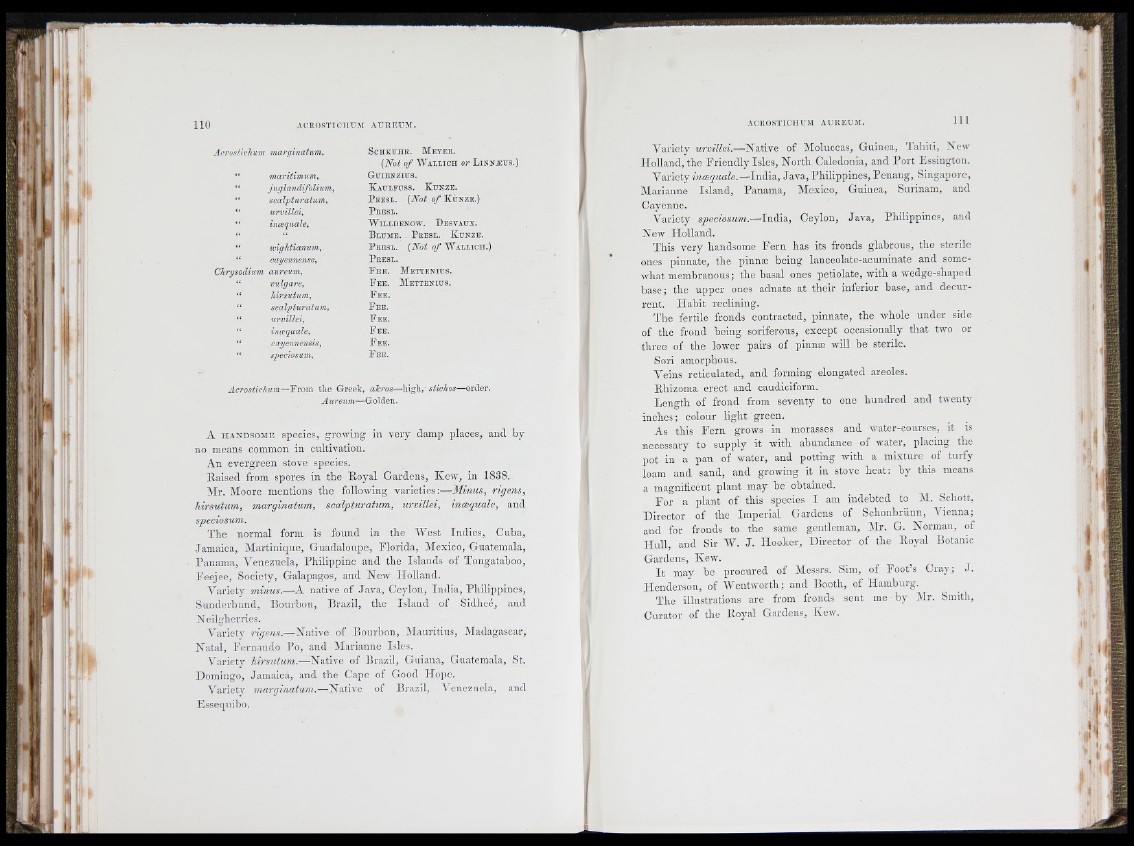
110 A C I1 0 S T IC IIU ^ [ AUREXJM.
Acrosdchum marginatum,
“ mavitimum,
“ jugland/foliiim,
“ scalptiiratum,
urvillei,
“ inoequale,
“ sviqlitianum,
“ cayennense,
Chrysodiuin aureum,
“ vulgare,
“ Jdrsutuim,
“ scalpturatum,
“ urvillei,
“ inaquale,
cayennensis,
“ speciosum,
S o n K u n n . M e y e k ,
(N o t o f W a l l i c h or L i n n z j u s . )
G n iE N Z in s .
K a u lex is s . K u n z e .
P e e s l . (N o t o f K u n z e . )
P e e s l ,
W i l l d e n o w . D e s v a u x .
B l u m e . P e e s l . K u n z e .
P e e s l . (Not o f W a l l i c h . )
P b e s l .
P e e . M e t t e n iu s .
F e e . M e t t e n iu s .
F e e .
F e e .
F e e .
F e e .
F e e .
F e e .
A C R O S T I C H U M A U R E U M . I l l
Acrostichum—From the Greek, ahros—Iiigk,' slichos—order,
A u reum—Golden.
A HANDSOME sjiccies, growing in very damp places, and by
no means common in cultivation.
An evergreen stove species.
Raised from spores in the Royal Gardens, K ew , in 1838.
Mr. Moore mentions the following varieties:—Minus, rigens,
h irsutum, marginatum, scalpturatum, urvillei, incequale, and
speciosum.
T he normal form is found in the "West In d ie s, Cuba,
.Jamaica, Ma rtinique, Guadaloupe, F lorida, Mexico, Guatemala,
Panama, Venezuela, Philip p in e and the Islands of Tongatahoo,
Feejee, Society, Galapagos, and New Holland.
Va rie ty minus.—A native of Jav a , Ceylon, In d ia , Philippine s,
S unde rb u n d , Bourbon, Brazil, the Island of Sidhce, and
Ncilghcrries.
Variety r/ye«s.—Native of Bourbon, Mauritius, (Madagascar,
N a ta l, Fernando Po , and Marianne Isles.
Va rie ty hirsutum.—^Nativc of Brazil, Guiana, Guatemala, St.
Domingo, Jamaica, and the Cape of Good Hope.
Va rie ty marginatum.—Native of Brazil, IT n e zu e la , and
Fsseqiiibo.
V ariety urvillei.—^Native of Moluccas, Guinea, T ahiti, New
Holland, the F rien d ly Isles, N o rth Caledonia, and P o rt Essington.
V ariety ineBquale.— l a M , Java, P hilippine s, Penang, Singapore,
Marianne Island, Panama, Mexico, Guinea, Surinam, and
Cayenne.
Va rie ty speciosum.—In d ia , Ceylon, Jav a , Philippine s, and
Nesv Holland.
This very handsome F e rn has its fronds glabrous, the sterile
ones pinnate, the iiinnæ being lanceolate-acuminate and somewhat
membranous; the basal ones petiolate, with a wedge-shaped
base; the u p p e r ones aduate at th e ir inferior base, and d e cu rrent.
H ab it reclining.
T he fertile fronds contracted, pinnate, the whole un d e r side
of the frond being soriferous, except occasionally th a t two or
th re e of the lower pairs of pinnæ will be sterile.
Sori amorpihous.
Veins reticulated, and forming elongated areoles.
Rhizoma erect and caudiclform.
L en g th of frond from seventy to one h u n d re d and twenty
inches; colour lig h t green.
As this F e rn grows in morasses and water-courses, it is
necessary to supply it with abundance of water, placing the
pot iu a pan of water, and potting with a mixture of tu rfy
loam and sand, and growing it in stove h e a t: by this means
a magnificént plan t may be obtained.
F o r a plant of this species I am indebted to M. Schott,
D irector of the Imperial Gardens of Schoiibrunn, Vienna;
and for fronds to the same gentleman, Mr. G. Norman, of
H u ll, and Sir IV. J . Hooker, Director of the Royal Botanic
Gardens, Kew.
I t may be procured of Messrs. Sim, of F o o t’s Cray; J.
H en derson, of "Wentworth; and Booth, of Hamburg.
T he illustrations are from fronds sent me by Mr. Smith,
Curator of the Royal Gardens, Kew.
i !